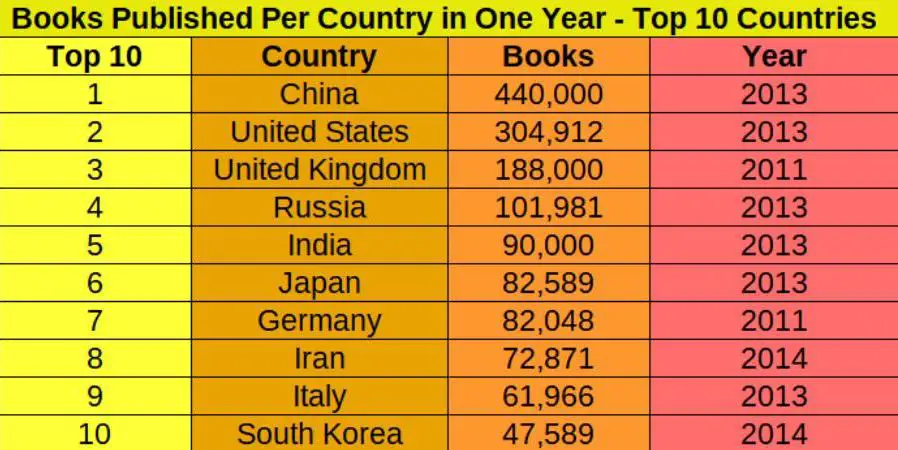How Many Books Have Been Written?

Book writing has been a part of human civilization since the beginning. Precursors such as oral storytelling or cave paintings set the stage, and later the Egyptians were the first to come out with papyrus scrolls. But how many books have been written?
Estimates range from 100,000,000 books upwards, but there are serious issues with the data including double-ups, translations and many other confounding problems. The figures reveal that anywhere from 1 to 3 million books are published each year.
We’ll look at the publishing industry and statistics regarding books to try and nail down exactly how many books have been written. We’ll also look at reading and ownership habits as well as self-reported data to try and get a good estimation of how many books there are.
How Many Books Are Written Each Year?
Another interesting data point is the estimates made by analysis of big data, such as that done by Google. From indexing, trawling and other estimates, Google puts the figure at over 130 million books in existence.
Interestingly, it was the quest to index books that was the original form of Google’s current iteration. However, even this figure is fraught with issues, as it is an elimination approach rather than a classification approach.
Google has a huge metadata collection of media. They then apply algorithms that try to curate this list by removing obvious duplicates and non-books. This is how they got to the 130 million figure, and there is plenty of criticism that this is not even close to correct.
Google states that as they get their metadata from libraries and their catalogs, it’s not like they are the only ones at fault here. Publishers have also not been consistent, especially with their tagging of books for genres.
However, there have also clearly been mistakes on Google’s part as many misdated books were in fact correctly listed in the major libraries of institutions such as Harvard and Berkeley.
Some funny findings by people who investigate this are the presence of the term ‘internet’ in books written pre-1950 or the vast amounts of books misdated to 1899. This comes down to Geoff Nunberg calling the data a ‘mish-mash wrapped in a muddle wrapped in a mess’.
Google is unlikely going to be able to solve this problem that has plagued human historians, codicologists, paleographers, library scientists, museum curators, textual critics, and bibliophiles to the satisfaction of most professionals and scholars. But it’s a good start.
Data is hazy given the huge number of publishers, self-publishers, double-ups, new editions and many other factors. Number crunching back in 2013 revealed that 2.2 million new titles are published each year.
China was first with approximately 440,000 new titles, followed by the US at over 300,000, and the United Kingdom with 188,000. Many other countries did over 50,000 a year, with other large markets also putting out at least 10,000 new titles.

More recent data from 2015 shows a similar trend line, with China publishing 470,000 and the US with 330,000. Regardless of the fluctuations, it seems that between China and the US, approximately half of total world book sales come from these two countries.
While these huge numbers may make being an author seem like a good career choice, the statistics are not good. Overall book sales are declining, and this is thought to be a function of the total oversaturation of the market. Some authors do well, but average revenue is bad.
New titles not only have the obstacle of competing with the annual millions of recently published books, but also the tens of millions of other books already available for sale. Of course, the internet and media are big competitors for your reading time.
The availability of digital books has in a sense opened up new sales channels, but in the end the overall number of purchasers has not risen. It is thus more convenient to purchase the books but it has not come with a subsequent rise in sales.
How Many Books Are Published Each Year in English?
There are several pieces of data which can help piece together how many books are published each year in English.
UNESCO, a United Nations agency, collects data about how many books are published yearly in each country. This data is covering new titles but also new editions or re-editions.
Other data collected by Bowker claims over 2.7 million books were printed in English in 2015. In the end, all of these sources control a certain amount of books, via publishing or registration, but do not account for other companies or authors who publish.
There are huge issues with representation amongst this data, as smaller publishing houses will not get counted despite adding thousands of books to the total. There are also issues with titles varying slightly but the alteration getting counted as a unique book.
However, the collection of this data is not as easy as it may seem, as there is no agreed upon international standard regarding tracking or what constitutes publishing.
Going off the UNESCO reports, the United States is likely responsible for anywhere from 150,000 new titles a year up to 400,000 titles a year, which will fluctuate dramatically.
When other sources are taken into account, such as self-publishing, the figure is more like 4 million annually, according to data from Proquest.
There are many other large English-language book markets. Largest after the US is the UK, Canada and Australia are significant, and English-language novels are published elsewhere including in countries that do not count English as its main language.
Smaller markets like New Zealand and various countries throughout the word contribute further numbers to the total as well. However, there’s also redundancy due to publishers pushing regional variations of the same book to several markets.
There is also the issue of books being put back into circulation with minor updates or edition changes, but these still can get counted amongst published works for a given year.

The large numbers of published books reported annually is misleading because over two thirds are self-published, reprints of public domain or print on demand.
The UK publishes approximately the same amount as the US on a per capita basis.
Further, the assumption that every book produced in these English-speaking countries is written in English is not borne out. The US has collected data revealing that over a fifth of the US population speaks a language other than English at home.
It can only be expected that a proportion of US-based writers will therefore at least occasionally publish books in languages other than English.
Certain spheres of publishing also tend to only print in English, or dominate the language tables with English publications. The technical and scientific world is awash with English language publications.
This has gotten to such levels that in many countries where English is not the main language, it has become the lingua franca in order to enable ease of access of scientific knowledge and discoveries, particularly in countries like Germany, France and many others.
English publications in many of these countries far outstrips those written in the local language.
Self-Publishing
Self-publishing has absolutely exploded in popularity since 2010. Figures from Bowker, an official source for publishing in the United States, show that over 1.68 million books were self-published in 2018. This is a 264% increase in just five years.
This data is not complete, as it only counts those on ISBNs registered. ISBNs are a barcode and number that uniquely identifies your book.
An ISBN will also allow you to better manage your book’s metadata, and ensure maximum discoverability of your book as it will be added to registers.
However, you don’t need an ISBN for a book and if you choose to self-publish through someone else, notably Amazon, they will provide you with an Amazon identifier. Figures for Ebooks on Amazon are not released, but their print division put out 1.4 million copies in 2018.
Other big companies like Lulu, Author Solutions, Smashwords all focus on self-publishing, and between them all there are approximately 100,000 titles.
How Many Books Does the Average Person Own?
Finding out how many books people own is hard as it relies on self-reported figures and extrapolation from book sales.
Pew Research findings from 2015 found that while the consumption of print books is on a downward trend, this is also influenced by the overall downward trend of adults who identify as readers.
The move towards ebooks and audiobooks also makes coming up with a final figure difficult.
One data point that could shed light is answers to surveys about reading. Pew Research’s sources and analysis points to women, young adults, high educational attainment and high incomes are the best determinants on the number of books read in the past year.
The differences are stark, with close to 90 percent of college graduates reading at least one book a year, compared to those who haven’t finished high school reading less than 34 percent of people.
In 2015, the percentage of adults who had read at least one book at least in part over the last 12 months was 72%. You don’t have to own a book to read it, so this doesn’t tell us a whole lot about book ownership.
Among all Americans, the average number of books read in the previous year was 12. Other information, such as the median number of books read being four, suggests that it is a small group of voracious readers pumping up the stat.
Kantar Insights did surveys that reported over 50% of UK adults had read a book in the past year over 2020, with 34% of readers managing over 10. This rate of a little under a book a month would put you in the ‘heavy reader’ category.
Reports of business leaders and politicians being huge readers are anecdotal but do gel with common sense. These figures could be as high as five books a month. Further to this, it doesn’t seem that all these books are business-related, with novels and plays featuring too.
The numbers also suggest that the older generation are reading less than their younger cohorts. 28 percent of adults over 50 reported not reading a single book, while less than 20 percent of adults under 50 are in the same category.
This is clearer upon the fact that 27% of adults said they hadn’t read a single book over the past 12 months. Other research from Gallup shows that this is not particularly unusual and the trends regarding reading have not shifted significantly.
Further, these statistics also don’t talk about the length or quality of the books read. Thus, while the numbers don’t show a massive decrease in the numbers of people reading, it could be that people are just reading shorter books as opposed to long form ones.
Another insight into how many books the average person owns can also be garnered from reading statistics. India tops the list with an average of over 10 hours per week spent reading. Following are other countries such as Thailand with over 9 hours and 8 in China.
The other complicating factor is the market for books is often a transitory one. Many people will borrow a book, read it, and return it. Even after buying a book, many will just hand it off to a friend or colleague for them to read, with little expectation of ever getting it back.
However, does this count as owning a book? If you only had the book in your possession for less than a month or so, but still read it, who gets credited with owning it? If you have a huge library of ebooks in cloud storage, do you count them as books you own?






